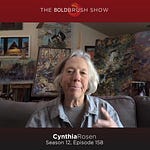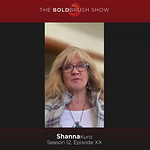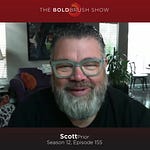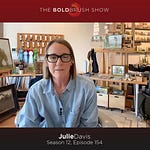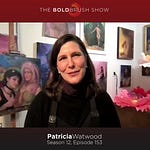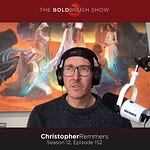Show Notes:
Learn the magic of marketing with us here at BoldBrush!
https://www.boldbrush.com/
Get over 50% off your first year on your artist website with FASO:
https://www.FASO.com/podcast/
Order your exclusive da Vinci BoldBrush paintbrush set!
https://brushoffer.com/collections/boldbrush
---
For this episode, we compiled insights from artists on the benefits of having and maintaining an email newsletter. Our guests share how a well-curated newsletter can foster deeper connections with fans, turning casual followers into loyal supporters. You'll hear tips on how newsletters can be used to promote new artwork, offer exclusive content, and build a dedicated community outside of social media platforms. They also discuss the advantages of owning your own contact list, and share strategies for keeping subscribers interested, such as sharing behind-the-scenes stories or exclusive previews. Tune in to learn why investing time in a newsletter can lead to long-term success and growth for your art career.
Episodes featured:
62 Aaron Schuerr
70 Kathie Odom
71 Matthew White
75 Otto Sturcke
81 Steve Atkinson
87 Johanna Spinks
94 Karen Blackwood
99 Heather Arenas
---
Transcript:
Aaron Schuerr: 0:00
My newsletter is gold, because it's a place so social media, you know, Instagram, Facebook, that's a great it's like the gateway drug. It
Johanna Spinks: 0:13
is very useful, I mean, in terms of marketing and your brand. And there's never been an easier time to get your artwork in front of eyeballs. If your aim is to sell your art, you
Matthew White: 0:26
could put a lot of content out on Instagram or Tiktok or or even YouTube. But if you're not capturing that audience and trying to start an engaged email list, you're really missing out.
Laura Arango Baier: 0:38
Welcome to the BoldBrush show, where we believe that fortune favors a bold brush. My name is Laura Arango Baier, and I'm your host. For those of you who are new to the podcast, we are a podcast that covers art marketing techniques and all sorts of business tips specifically to help artists learn to better sell their work. We interview artists at all stages their careers, as well as others we're in careers tied to the art world. In order to hear their advice and insights. For this episode, we compiled insights from artists on the benefits of having and maintaining an email newsletter. Our guests share how a well curated newsletter can foster deeper connections with fans, turning casual followers into loyal supporters. You'll hear tips on how newsletters can be used to promote new artwork, offer exclusive content and build a dedicated community outside of social media platforms. They also discuss the advantages of owning your own contact list and share strategies for keeping subscribers interested, such as sharing behind the scenes stories or exclusive previews. Tune in to learn why investing time in a newsletter can lead to long term success and growth for your art career.
Aaron Schuerr: 1:39
I had this idea that, when I was going into it, that everybody else had the manual, you know, they how to be the artist manual of some kind. And I always felt like I was the only one that didn't have it. And then you start talking to other artists and realize that everybody feels like that. So one don't feel like you need to have everything figured out and together. It's always a learning process. I'm still I've been added a while, and I still feel like there's so many areas that I can streamline things or learn whether it's on the financial side or it's on the the improving as an artist, I would say one really, really important thing that I would tell my younger self is keep track of Your collectors and the people that you interact with. I was not good at doing that. You know, one of my early on, one of the the things that really helped my career, was the CM Russell exhibit. It was a week up in Great Falls, Montana, that a hotel was converted into gallery spaces, and so it got my work out there in a way that I hadn't been out there before. And so I and it also got me direct sales, and I didn't really keep track of those people back then, and I think that was a major missed opportunity. I'm still struggling with this. I'm getting better, but so like for me now, my newsletter is gold, because it's a place so social media, you know, Instagram, Facebook, that's a great it's like the gateway drug. Your work gets out there, and it's fun to have that kind of instant response, whether it's to a painting or real or but I I'm I've only made sporadic sales through social media, but getting people over to my newsletter where I people are choosing to open the emails. You know, it's their choice I send out the emails, their choice to open it, versus Instagram, where they're just they're scrolling and maybe it catches their eye, and so they're choosing to read it, so that means they're actually following you. And so since the pandemic, that kind of direct relationship has been really, really important to keeping it's it's galleries are still very, very important having really good relationships with my galleries, making sure that I'm communicating with my galleries, keeping them supplied with work, is really, really important. Because for me, like the galleries are places where you know, like, behind you is a large painting that's. That's something that would go in a gallery. They're better able to handle work like that. But, you know, sometimes doing little, I've done a number of fun projects that I've shared with my newsletter subscribers, usually with smaller paintings that kind of augment the gallery sales. And make things a little bit more stable.
Kathie Odom: 5:26
I would say that when we did start thinking in that way of marketing, something that was just resound in me was it's got to be about the art, not just a unique way of showing the art. I mean, although that all of that happens, but first and foremost, the first thing is, it's got to be about the art. And I think instead of, you know, just, I mean, buddy has ideas just constantly and it there. They've been great ones. And I would say Faso has been a gift to us, and the fact that it offers, I would say the best marketing thing we have done, which is totally buddy putting it together, has been the newsletter connection on our website, which is our Faso website, and I know that that's who I'm talking to right now, but I would say this to anybody that that was a tool that has gone out. We've done a newsletter once a month for about eight years. For eight years, it happens at the beginning of the month, sometimes a couple of days late, but I've never seen somebody stay on something like buddy has, and it's all about what's happening. Now, you know, what workshops are we? Am I teaching? What trips are we going on? What where are we? What have I been painting lately? And that has been probably one of the best marketing tool. It's definitely, yeah,
Buddy Odom: 7:23
way to go. Faso, wait, way to go. But it is. Anyone listening, I'm telling you, start a newsletter. You know, the best time to plan a Sequoia is once heard was like 800 years ago. The second time, the second best time to plan a Sequoia is today. So you start something that's gone. We've gone eight years at this every month, and it's not too much by you know, it's we have done it every two or three weeks or one week, and we haven't skipped times. We've just stayed steady. And her her following has grown over eight years all by itself. And people subscribe to the newsletter. Hopefully the paintings had a little something, had nothing to do with it whatsoever, because it's a full circle to what she's really full circle to what she's really saying is it's about the art and we and of course, there's an artist behind the art, but you lead with the beauty, and then you find out who's, you know, busy creating that, and how she goes about it, and you become very intrigued with that. But if you're not hooked on the art, I mean, how are you going to get hooked on creating something that you don't care about? So yeah, it's about travels and workshops and and galleries and new release paintings. And if that
Matthew White: 8:37
is a goal that you have, it takes time. You know, it really does. And if that is your main goal, you're probably going to get really frustrated because it doesn't happen quickly. You know, some people, it might happen faster for some people, but for me, it was showing up consistently, every week, not missing a week for, you know, two or three years before you can see larger numbers like that. I wanted to add one more thing about the email list, because that's what I tell other artists all the time, is that right now, at a time when there is so much going on with social media and platforms are changing, algorithms are changing Tiktok or Twitter changes to x overnight, and everything is different over there now, Instagram favors reels now, and video even more so than a photo. So we're constantly trying to regain our footing when it comes to social media. That's why, more than ever, an email list is so important. You own that audience and it you know the you could put a lot of content out on Instagram or tick tock or or even YouTube, but if you're not capturing that audience and trying to start. An engaged email list, you're really missing out, because things can change over time, but that email list is is more valuable to me than anything else. So I encourage anyone out there who even wants to sell their art or some type or if they want to have some product in the future, they don't even know what it is yet. When you're at an art show, put out your little book, say, sign up for my email list. When you put things on Instagram, when you put things on YouTube, try to promote people and give them a reason to sign up for your newsletter. If you just say, I have a newsletter, you know, nine out of 10 people aren't going to care, so give them, give them a great reason to sign up, because you collecting those names over the years is so valuable because your open rate and your emails is always going to be higher than the algorithm that feeds people your stuff on on, you know, Instagram or anything else you know, people
Otto Sturcke: 11:02
maybe have lost the value of sending a postcard, sending a letter to people, and that helps out immensely. You know, years ago, I taught, I gave classes to Tom Kinney. Tom Kinney is a voice of Spongebob, and I gave art classes to his son and his daughter, and to this day, he still makes a donation in my name to I think it's if I remember quite well. I think it's for cancer research. I'm trying to remember what it is, but either way, I just think it's so nice to be able to get, every year, get, get a postcard, you know, Christmas card from that and, you know, it's like, wow, okay, you know, I touch somebody in that sense, you know, where I was able to make a little bit of a difference, and so and so, I think postcards and sending, so a message in the mail. Old school is still very valuable. It's, it's, it's helped me anyway, and I, I, I, I, I've been again, I keep using that word fortunate, because, yeah, I've been very fortunate to have those connections so and, but you gotta work from, you gotta work from and, and, and I think if, if you're genuine in in what, in your craft, and if you're you're trying to be very genuine, the communication that you're trying to well, with the message you're trying to convey is that, yes, I'm, this is my artwork, and this is what I'm trying to say, and this Is what I'm trying to do, you strike struggle, conference, conversation and and something, sometimes it turns into, you know, what? I really love that piece. I want to take it with. So, you know, it's, it's again, it's, it takes some time, take some doing. And I feel like, again, if you know, just going back to this whole social media, and what it is that seems to be working for me is again, the the the connections that I make through newsletters and and postcards and and driving somewhere to see somebody and just having lunch or whatever it might be just, You know, just talk about something other than just art. Not
Steve Atkinson: 13:23
only did he trade for food and some lodging, but he also traded with a lot of other artists. So Joanna not only got a lot of his paintings, but she got a lot of other Impressionists who were just starting out. So she did, she did okay, but you know, she didn't have to do that. No, but yeah. And you know, it's kind of the same way to this day, just because so many artists have gone down the abstract path. And you know, for me, I don't understand it. I would never poo, poo it if someone loves it. But trying to be a representational artist in this day and age where you have to be wild and really out there, it's difficult. It's difficult to get that underneath your you know, they to get that traction. And so one of the other things that I will say as far as this being relationship driven career and that is, I've gotten into two of my galleries, my main galleries, actually, yeah, two of my main galleries because I was in a show, and the either the gallery owner came up to me afterwards and said, we'd love to represent you. Or the judge came to me afterwards and said, Would you like to meet the Galler this gallery owner that that that he was in. And I said, Absolutely. And so I this was now before they had, um. You know, all these books that you could do, this was a print on demand, and so I did my portfolio as a as a hard cover book, and I sent it out to the gallery owner, and that's how I got in. Just you do your very best work, you stand out from the crowd. You're not afraid to you always gotta ask for the sale. You know, that's another big thing with trying to make an impression and make inroads into making a living as an artist. Never be afraid to ask for the sale. And when I first started out, I never asked for the sale. You know, if you were looking at one of your pieces of art in a show and someone you were talking with someone, you can always just say, you can, I wrap it up, you know, I can. I can come out and hang it in your in your house. I'd be happy to do that. And you would be surprised the number of times people say, Yeah, okay, let's do that. And so, yeah, that's, I think that's probably one of the biggest pieces of advice. And the biggest epiphanies that I had was people just want to be invited to make that sale, you know. And sometimes you can do it on Instagram, or you can do it on Facebook. If someone shows an interest, personal message them and say, I know that you you like this work of art, I can it's available. What do you say? We we make this a done deal. So, and that does work, doesn't always work, but you know, even if they don't buy that one, you've made another friend. Ask them if they you can put them on your newsletter, you know, and send them that and stay in contact with them. People. People really appreciate that, you know. So
Laura Arango Baier: 16:45
especially if we look at work, yeah, yeah,
Steve Atkinson: 16:48
yeah. I mean, if they obviously, if they're looking at someone else's work, don't go up and ask them if you can put them on your newsletter. But if you've talked talking to them a little bit, yeah, people, people generally, will say, Yeah, okay, you know. And the ones that say no, well, you want good people that are on your on your newsletter. Anyways, as far as you want people who are interested, not just one of the things that we used to do when we had the open studio here is we would have a giveaway of a print if you signed up for the newsletter. But what we found is that people were just signing up to get to print, not necessarily who are interested in in seeing your work or collecting your work. So we've stopped doing that in favor of asking people, once we've talked to them, if they'd be interested in getting on the newsletter
Laura Arango Baier: 17:38
at BoldBrush, we inspire artists to inspire the world, because creating art creates magic, and the world is currently in desperate need of magic. BoldBrush provides artists with free art marketing, creativity and business ideas and information. This show is an example. We also offer written resources, articles and a free monthly art contest open to all visual artists. We believe that fortune favors the bold brush, and if you believe that too, sign up completely free@boldbrushshow.com that's BOLDBRUSH show.com. The BoldBrush Show is sponsored by Faso. Now more than ever, it's crucial to have a website when you're an artist, especially if you want to be a professional in your career. Thankfully, with our special ink FASO.com/ podcast, you can make that come true and also get over 50% off your first year on your artist website. Yes, that's basically the price of 12 lattes in one year, which I think is a really great deal, considering that you get sleek and beautiful website templates that are also mobile friendly, e commerce, print on demand in certain countries, as well as access to our marketing center that has our brand new art marketing calendar. And the art marketing calendar is something that you won't get with our competitor. The Art marketing calendar gives you day by day, step by step, guides on what you should be doing today right now, in order to get your artwork out there and seen by the right eyes, so that you can make more sales this year. So if you want to change your life and actually meet your sales goal this year, then start now by going to our special link, FASO.com/podcast. That's FASO.com/podcast.
Johanna Spinks: 19:19
It's very useful, I mean in terms of marketing and your brand, and there's never been an easier time to get your artwork in front of eyeballs if your aim is to sell your art. I have many good friends who they have no interest in selling their art, and they are fabulous painters, so that doesn't apply to them. But if you are interested in selling your art, getting into galleries or whatever it is, the internet is a wonderful tool, if used wisely. I when I first started, you know, seeking out commissions that there wasn't an internet. It was all, can you imagine? It was all done by, oh, let's send out a mail. Let's send out a, you know, a holiday greeting card, etc, etc. But the good news of that was you were doing direct one to one marketing, where you were sending in a handwritten note to the person you knew, the person they knew you. And that was that is something that I'm still very grateful for, because those early commissions, those people are still now reading my email newsletter, and we're talking 20 years later, their kids have grown up, you know? And to me, that's that's something really to learn, that that that one to one is still very, very important. And I think in terms of marketing our art, we have forgotten that for those of us that are really in the sort of newer world, digital world, forgotten. And you know, in my opinion, and I can only speak from my own opinion, but Instagram and Facebook are just part of of what I think I should be doing my main my main thrust is still the as much direct communication as I can get with people is still my goal, you know, I mean, I'm, you know, even in the the thrust of My artwork, I'm interested in the direct interaction with people, the sitter, the person on the street. You know, I'm a people watch. I'd rather be sitting in a sidewalk cafe than in a forest. That's just me. You know, I'm interested through my portrait art, in, you know, the unique thread of humanity that connects us all. And the other thing I like, I've been really interested recently in this motivational author called James clear, and he's written a very successful book called atomic habits, and he doesn't call it a mountain, he calls it an iceberg, right? So you've and this was very interesting. I was just listening to his master class on the plane back from New York last week. So he calls it an iceberg. And you know, what is that iceberg bit at the top there? Maybe it's a collection of store life paintings you're trying to sell, or a art workshop internationally, or whatever, or getting a big portrait commission. So you've got the tip of the iceberg, and then you have underneath the ice, underneath water. You have to get your systems in place. He calls it your systems in place, because chances are, if you don't put those systems in place, you're not going to get that workshop filled internationally, or you're not going to get that big commission, or you're not going to get that collection of beautiful still lifes into a gallery. And those systems in place, of course, are all the things that we have talked about. You know, your subscriber list, your your getting in front of as many eyeballs as you can, but but a fairly worked out plan of what you are going to do to make that happen and, and the other thing he talks about is that just do a little bit every day, you know? Because sometimes the task seems so overwhelming, and I have felt that, that you kind of go so, you know, okay, you've got it. You've got to go and write another newsletter, and you don't know what on earth you're going to write about yourself, because it's a delicate balance. You're selling yourself in a newsletter, but you have to make it look like you're not, yeah, so
Laura Arango Baier: 23:28
because it can feel a little bit slimy,
Johanna Spinks: 23:31
yeah, and I'm sure quite a few of mine have felt slimy, but because you're selling but so, so probably it's something that I put off. I mean, I certainly don't do more than four a year my list. Do not want to hear from me every month, that's for sure. And actually, three a year is better for me. But I put it off, you know, because it's just overwhelming, and you've got to do all the links, and you've got to do this, and you do that, and I'm like, Oh, I'll do that tomorrow. I'll do that tomorrow, you know. And then I'll, you know, say, Well, if I just go in and do five minutes today, just put a few images in there, and then do five images tomorrow. And then the thoughts that I want to write about will actually come to me, because obviously, the images are usually something that you've been creating recently, or, you know, and then also share something, if you can about, you know, how to frame a or hang a painting in the best possible way. Or, you know, try and share a little bit too. Yeah,
Laura Arango Baier: 24:26
I love that because, oh, it is so easy to get overwhelmed as an artist, especially because I really like to compare it to the 8020 rule. It's a little bit like what you said about the iceberg, where, if you want 20% right, 20% is the important stuff, right? But it takes 80% of everything else that of those systems, those systems are that 80% of making sure you're even painting, of reaching out to collectors, of updating your website, of sending out the newsletters, of basically keeping everything just in order so that you get that little 20. Percent at the top that's peaking out of the iceberg, which can be really overwhelming. And also, I love the Kaizen thing where, you know, taking it a little bit at a time, doing a little bit each day. It's kind of like if you have a giant cake in front of you, right? You can't eat the whole thing in one sitting, but you can eat a little piece every day, and before you know it, the cake is gone.
Johanna Spinks: 25:23
That's so true. And the other thing I really liked about Mr. Clear is that he said saying no. And this is something that I think I have learned over the years, but it was good to see it in writing. Saying no is the biggest productivity hack, you know, because how many times do we say yes to things that take up so much time? So if you're going to say yes to something, you know, maybe to the more beginner artists building their careers, if you're going to say yes to something, make sure that yes is leading you to your goal. I have said yes to so many things over the last 25 years that I thought would benefit me. And you know, it just turned out well, wow, that just took a huge chunk of my day, my week, when I could have been painting and doing that newsletter.
Karen Blackwood: 26:18
I actually have one collector that is one of my best collectors who found me online when I lived in Michigan and bought a piece and continues to buy my work out here now, and I've had her to my home, and I usually will have a once a year salon show at home where I invite only my collectors or future collectors, kind of like a way to just show them what I'm working on, so they become, you know, friends and I value them. And then through my galleries, I would say, you know, they maintain a really strong relationship with collectors. And anytime I'm working on a new piece, they'll make sure that collector gets to see it. And then out on social media, you know, people get stay in touch, and the newsletter actually on the Faso website, my newsletter, I built strong following during COVID. I couldn't paint my large paintings. I thought I would kill them, and I and I knew I had to paint, so I did a that I could keep working, and I knew I could sustain focus for, you know, a six by eight. So I think I painted about 80 of them, close to 80, and sold them all through my newsletter on Faso. So I would let the buyers know that, you know, next Tuesday, you know, look for my newsletter and and first come, first serve, it gets sold to, you know, whoever tells me I want it. And so I built up, you know, I think I added 400 followers from that campaign on that, on that newsletter, because they were buying the painting. So, so the newsletter is also a big thing. I would say, social media and keeping in touch through a consistent newsletter on Faso has been, yeah, fine art studio online, for those who don't know, yes,
Laura Arango Baier: 28:46
yeah, that's, you know, I love that you bring that up because I think that's another thing that's pretty underrated. You know, people, the real people who sign up for your newsletter are people who are actually interested in buying right? Because, like your followers on Instagram, they're sometimes they're just there to support, or just there to be looky loos or to be inspired. But then the people who really are interested and want to know more and want to be engaged, they will definitely sign up for for a newsletter, and maintaining that list is also very important. Yeah,
Karen Blackwood: 29:14
exactly, yeah. Those are the people who a lot of them are artists themselves, and a lot are actual art buyers or or people who have a love for the arts. And you know, you know your work is speaking to that person because they've taken the time to sign up. And, yeah, that actually, I sometimes forget to be as consistent if I don't have a campaign or something going, but it is important to maintain that relationship, because they signed up and they, you know, they want to know what's happening and what's new. Yeah. Yeah, yeah. And
Laura Arango Baier: 30:01
it's a lot more, I guess it's a lot more intimate in that way, because on social media, it's just an image. Maybe you'll put like a little paragraph underneath, but with a newsletter and and if you also keep a blog, which I know that on Faso, you can have a blog, you can also write longer form things, and there are people who will read it, they'll comment and they'll email you, and I think that's such a wonderful thing.
Karen Blackwood: 30:22
Yeah, I love getting the emails back. I love when I send the newsletter out and I'll get you know responses back, even if it's just to say hi or, you know, got it? Yeah? I love that.
Heather Arenas: 30:34
Well, first, I will say that your relationship with your gallery is one that you nurture. And my galleries are a partner with me, like we are both going for a good common cause. They want to make money, I want to make money, and so we're going to work together to make that happen. And I think that there are a lot of people who are like, Oh, the calories. Are trying to do me wrong, and that's just not the case. They just, they want to help you as much as help themselves. So it's definitely a partnership. And so we discuss, you know, whether or not they are willing to give me a collector's name, and am I going to go around them to go sell directly to that collector? Heck no, you know, I mean, I have a understanding with my galleries that I won't undercut them. I won't knock the sale out from underneath of them. Any collector that is connected with the gallery, I'm going to run that sale right through the gallery. So because it benefits me just as much, this is a long term relationship. So that being said, one of the things that I do is, if I know that I am going to deliver work, which the two galleries that I have right now are within driving distance, so I will drive my work to the gallery, and ahead of time, I'll send out a newsletter that basically says I'm going to be at the gallery on this date, and I would love to meet up, come and meet me at the gallery, and we can talk about this piece, you know. And so I've met a few collectors that way who've either already bought my work or have been dying to see the work in person, and they met me there, and we forged a relationship together. And that in person thing is just wonderful. I am I tried to do that as much as possible. Now I have collectors in England, in France, you know? I mean, I'm not going to get to meet every collector in person, but I love it when they engage with me. And so I will, sometimes, I'll post a photo of the painting, say, sold online on one of my social media sites, and then the collector will come forth and say, Oh, it was me that bought it. And I'm like, great. This is wonderful. Then I have a conversation that I can engage with them and find out a little bit more why they like the piece, a little bit more about them. And so I'm just always open to the conversation, I guess. And to that end, I send out a newsletter once a month or more, and I tried to post on my Instagram page two to three times a week. And yeah, I'm just me. I'm not nearly as polished as a lot as the a lot of the people who post on Instagram and all the videos that they're doing now. I'm like, I try, I do the best that I can, but I am what I am, and all.



